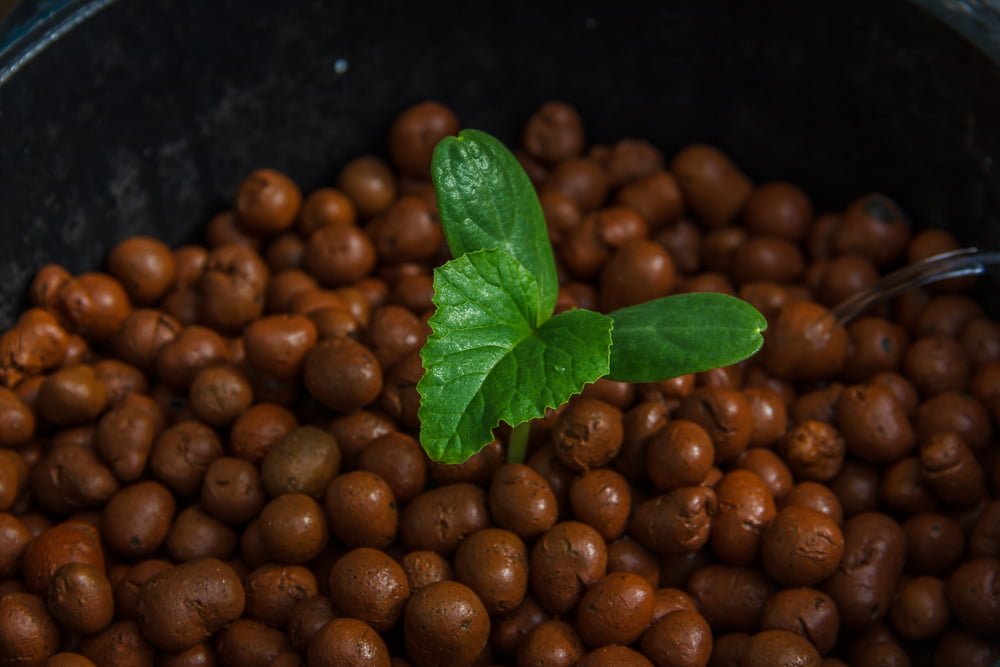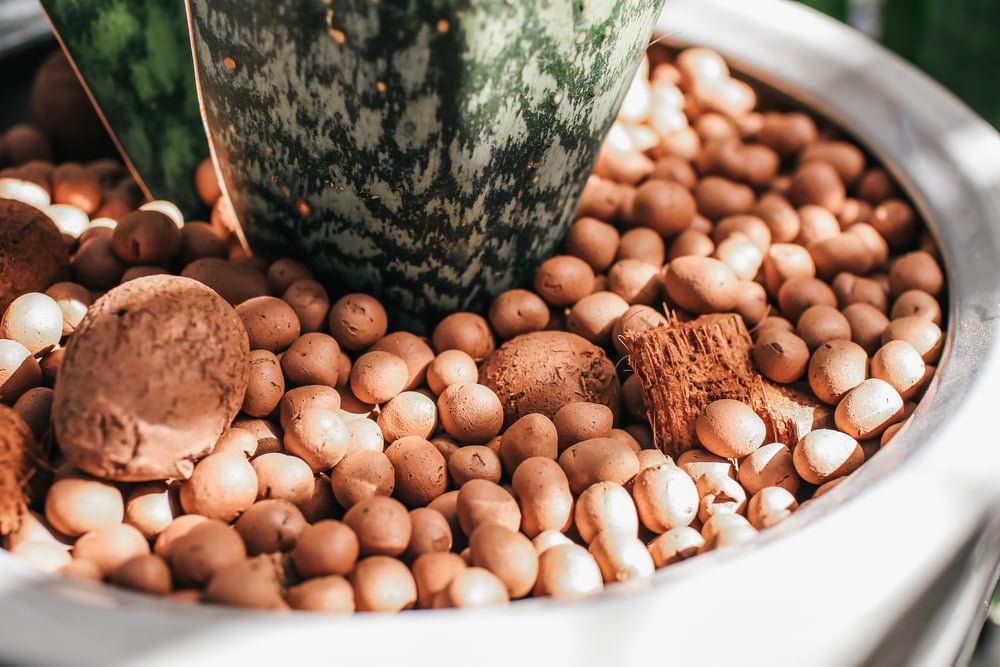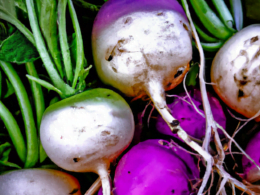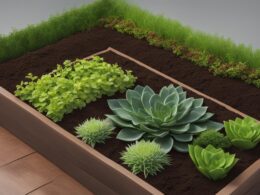What Is LECA?
LECA is a lightweight material made from expanded clay that is coated with a nutrient solution. It is commonly used as a growing medium for plants and has good water retention and aeration properties. It can also be used as a soil amendment, insulation, and construction aggregate. These small yet mighty spheres work wonders when it comes to helping our green friends stay happy, hydrated, and safe from harm!Understanding Clay Pebbles
Clay pebbles, also known as LECA (Lightweight Expanded Clay Aggregate) are an awesome way to grow plants. They come in different types, so you can pick the one that works best for your plants. Growing with clay pebbles is easy since they provide plenty of aeration and drainage to keep your plants happy and healthy. Plus, they can be reused over and over again! The benefits of clay pebbles are hard to beat. They retain water and nutrients, help prevent disease, and even give your plants an extra boost of oxygen. They’re a great way to give your plants the best chance of success.Types Of Clay Pebbles
LECA stands for Lightweight Expanded Clay Aggregate, and they’re made by heating natural clay at super high temperatures until it puffs up like popcorn. These clay pebbles come in different shapes and sizes but are mostly known for their porous texture that helps absorb water and nutrients while also providing excellent aeration for plant roots. Now, there are two main types of LECA: regular and semi-hydroponic. Regular clay pebbles are the ones you’ll find most often in gardens and nurseries – they’re great for mixing into potting soil to give your plants some extra drainage and airflow. On the other hand, semi-hydroponic LECA is specially designed to be used with hydroponic systems where plants grow directly in water without any soil. The cool thing about these clay pebbles is that they act like mini life rafts keeping your plant’s roots safe from drowning or rotting while still getting all the H2O and nutrients they need to thrive. So whether you’ve got a green thumb or not, using LECA can help make sure your plants stay happy and healthy no matter what!Growing With Clay Pebbles
 Now that you’re in the know about LECA and its two main types, let’s dive into how to grow with clay pebbles!
It’s like giving your plants a comfy, airy home where they can kick back, relax, and soak up all those good vibes (and nutrients).
You see, LECA is kind of like the superhero sidekick for your plants – it swoops in to save the day by making sure their roots don’t get too wet or dry.
Growing with clay pebbles is super easy-peasy. All you need to do is mix some regular LECA into your potting soil or use semi-hydroponic ones if you want to try out hydroponics.
Either way, your plants will be living the dream as they chill on their mini life rafts while drinking up all that delicious H2O and food they need.
So go ahead and give LECA a shot – it’s like plant insurance that helps keep them safe and sound!
Now that you’re in the know about LECA and its two main types, let’s dive into how to grow with clay pebbles!
It’s like giving your plants a comfy, airy home where they can kick back, relax, and soak up all those good vibes (and nutrients).
You see, LECA is kind of like the superhero sidekick for your plants – it swoops in to save the day by making sure their roots don’t get too wet or dry.
Growing with clay pebbles is super easy-peasy. All you need to do is mix some regular LECA into your potting soil or use semi-hydroponic ones if you want to try out hydroponics.
Either way, your plants will be living the dream as they chill on their mini life rafts while drinking up all that delicious H2O and food they need.
So go ahead and give LECA a shot – it’s like plant insurance that helps keep them safe and sound!
Benefits Of Clay Pebbles
Now that you know how to grow with LECA, let’s talk about the amazing benefits of clay pebbles, because who doesn’t love a good perk, right? These little marvels are like your plants’ personal bodyguards – they protect them from all sorts of dangers and help them thrive. With their awesome powers combined, LECA is here to make sure your green buddies stay happy and healthy no matter what life throws at them. The benefits of clay pebbles go beyond just keeping your plants safe; they also give roots room to breathe and spread out while making it super easy for nutrients to reach every corner. So buckle up, folks! We’re about to dive into a world where plants live in luxury thanks to these tiny but mighty superheroes called LECA.Benefits For Plant Growth
Let’s talk about the benefits that leca can bring to plant growth! It’s an incredible nutrient source, supplying them with all the goodness they need. Plus, it helps to improve soil structure by aerating the soil and retaining moisture. We’re essentially giving our plants a nourishing hug! Not to mention, it helps to reduce stress from pests or extreme weather conditions. All in all, leca’s got your plant’s back!Nutrient Supply
You might be wondering how leca contributes to the whole nutrient supply thing for plants, right? Well, you’re in luck because that’s exactly what we’re going to explore today! The magic behind leca lies in its unique ability to soak up water and nutrients like a sponge, then slowly release them back into the plant’s roots as needed. This means that our green buddies never go hungry or thirsty! Plus, since it doesn’t decompose over time (unlike soil), there’s no risk of harmful bacteria building up and causing damage. So not only do our plants get their fill of delicious nutrients from this fantastic clay aggregate, but they also enjoy a safe environment where they can grow big and strong.Soil Structure
Now, let’s talk about another super-duper important benefit of using leca: soil structure! You see, in the world of plant parenting, having a healthy soil structure is all about providing our leafy pals with just the right balance of air and moisture so they can breathe easy while slurping up all those yummy nutrients. And guess what? Leca happens to be an absolute rockstar when it comes to promoting optimal soil structure. Its little round pebbles create tiny pockets of space for air and water to flow freely around your plant’s roots, making sure they never feel suffocated or drowned. Plus, since it doesn’t compact over time (like regular ol’ dirt), you won’t have to worry about accidentally squishing any precious root babies. All in all, using leca as a growing medium helps ensure that your plants are living their best lives in a cozy and safe environment – talk about hitting the jackpot!Different Types And Brands
Organic fertilizers are a great way to give plants the nourishment they need without the worry of chemicals. Inorganic fertilizers are more of a quick fix, but can be harsh and have some nasty side effects. For those looking for a middle ground, there are brands like Hortico and Natura that offer a blend of both. Miracle-Gro, Osmocote, Schultz, EarthPods, Vigoro, Jobe’s, Milorganite, Master Nursery, Aqua-Feed, Ferti-Lome, and Nutri-Lawn are all popular choices for those wanting to give their plants a little extra something.Organic
You might be wondering, what’s all the fuss about organic leca? Well, let me tell you! Organic leca is a fantastic alternative to traditional soil for your plants. It’s made from a natural clay ball that has been heated up and formed into tiny pebbles or pellets. This makes it an excellent option for those of us who want to keep our beloved plants in tip-top condition while also reducing our impact on the environment. So why is organic leca so great for plants? For starters, it provides excellent drainage and aeration, which means your plant roots can breathe easy without getting waterlogged. Plus, because it’s made from 100% natural materials, you don’t have to worry about any nasty chemicals harming your precious green friends. In fact, many gardeners swear by using organic leca as a way to improve their plant’s overall health and vitality! So go ahead and give it a try – after all, isn’t keeping your plants happy and healthy worth giving something new a shot?Inorganic
Now, let’s switch gears and talk about inorganic leca for a bit. You might be thinking, ‘Hold up! We just talked about how great organic leca clay balls are – what gives?’ Well, it turns out that there’s more than one way to make a clay pebble, and some methods involve using non-natural materials. In fact, inorganic leca can actually have some pretty cool benefits too! Inorganic leca has its own set of perks that you might find appealing. For instance, it’s super lightweight and easy to handle (no breaking your back lugging around heavy bags of soil!). Plus, because it doesn’t contain any organic matter, you don’t have to worry as much about pests or diseases hitching a ride on your new plant buddies.Usage In Hydroponics And Aquaponics
Hydroponics is a great way to grow plants without soil; it involves using a nutrient-rich solution to deliver all the essential elements directly to the root system. Aquaponics is a cool mix of hydroponics and aquaculture that uses the waste from fish to feed and water plants. When it comes to nutrient delivery, LECA (Lightweight Expanded Clay Aggregate) is an important tool. It’s like a sponge that soaks up the nutrient solution and releases it gradually to the plants. LECA also provides an ideal balance between air and water, making it a great addition to any hydroponic or aquaponic system. Plus, it’s lightweight and easy to work with! You can’t go wrong with LECA when it comes to delivering essential nutrients to your plants.Hydroponics
You know how we all need a safe and cozy place to call home? Well, plants do too! That’s where leca pebbles come into play in hydroponics. Hydroponics is a way of growing plants without soil, using water mixed with nutrients instead. It sounds pretty cool, huh? Leca (short for ‘lightweight expanded clay aggregate’) serves as the perfect little house for plant roots to snuggle up in while they get their food from the nutrient-rich water. Now imagine you’re walking on some squishy wet marbles. Sounds weird, right? But that’s kinda what it feels like when you touch leca! These tiny clay balls are super porous and lightweight which makes them great at absorbing water and delivering it straight to the plant roots. In other words, leca acts like a helpful middleman between plants’ thirst for nutrients and the watery solution they need to grow big and strong. So next time you see someone experimenting with hydroponics, remember – leca has got their back!Aquaponics
Now that we’ve got the hydroponics part down, let’s dive into aquaponics! You might be wondering what on earth this has to do with leca and plant homes. Well, aquaponics is like the cooler cousin of hydroponics – it combines fish farming with growing plants in water instead of soil. Yup, you heard that right: fish and plants living together in harmony! In an aquaponic system, our little buddy leca still plays a super important role as the cozy home for plant roots while they soak up nutrients from the water. But here’s where things get really interesting: the fish waste (aka their ‘business’) becomes natural fertilizer for the plants! It’s like a circle of life thing going on – fish help feed the plants who clean up after them by taking care of business. How cool is that? So whether you’re team hydroponics or team aquaponics, you can always count on trusty ol’ leca to make sure everyone stays happy and healthy in their watery world!Nutrient Delivery
Now that we’ve got the lowdown on how leca works its magic in hydroponics and aquaponics, let’s talk about something super important: nutrient delivery. You see, for plants to grow big and strong, they need a steady supply of nutrients – kind of like how we humans need food to stay healthy! In both these watery systems, leca helps make sure our green pals get all the good stuff they need by acting as a sort of ‘delivery service.’ It holds onto those precious nutrients from the water so plant roots can easily grab them whenever they’re feeling peckish. Leca is really awesome at this job because it doesn’t hog any of the goodies for itself – it just passes everything along to where it needs to go. Thanks to its trusty sidekick leca, plants in hydroponic and aquaponic setups never have to worry about going hungry or missing out on essential nutrients. So there you have it: not only does leca provide cozy homes for plant roots, but it also makes sure everyone gets their fair share of nutrient-delivery goodness!Mixing With Traditional Soil
Mixing techniques when combining traditional soil and leca can be a tricky business. Leca, or Lightweight Expanded Clay Aggregate, is a great way to give your plants the extra boost they need. It’s packed with essential minerals and other nutrients, and it helps to keep the soil’s moisture level balanced. It’s perfect for plants that have a difficult time growing in regular soil. From succulents to ferns, leca ensures your plants stay healthy and happy. With leca, you can give your plants the best of both worlds – the soil they need to stay grounded and the extra nutrition they need to thrive.Mixing Techniques
Hey there, green thumbs! Let’s talk about mixing techniques for combining leca with traditional soil. You might be wondering why you would want to do that – well, it’s an awesome way to give your plants the best of both worlds. Leca provides excellent drainage and aeration while also helping to prevent over-watering, whereas traditional soil contains all the nutrients your plants need to thrive. So when you mix these two together, you’re creating a happy home for your plant pals. Now let’s get down and dirty with some mixing tips. To create the perfect blend, start by adding equal parts leca and soil into a container (like a wheelbarrow or large bucket). Then use your hands or a gardening tool to combine them until they’re thoroughly mixed – think of making brownies! The goal is to have an even distribution of leca throughout the soil so every root can enjoy its benefits. And don’t worry if things get messy; after all, playing in the dirt is half the fun of gardening! Once you’ve got everything mixed up, simply fill your plant containers with this new mixture and watch as your plants grow stronger, healthier roots than ever before.Benefits Of Leca
Now that we’ve covered how to mix leca with traditional soil, let’s dive into the benefits of leca itself. You might be thinking, ‘What’s so great about these little clay pebbles?’ Well buddy, you’re in for a treat! Leca is like a superhero sidekick for your plants – it swoops in and saves the day by providing better drainage and preventing root rot. The benefits of leca go beyond just fixing soggy soil problems. These lightweight clay balls also help insulate plant roots from extreme temperatures, keeping them cozy during chilly nights or scorching hot days. Plus, they keep pesky critters away since there are no tasty nutrients for them to munch on. So not only will your plants grow strong and healthy thanks to this dynamic duo of soil and leca, but they’ll also be safe from harm too. Talk about hitting the jackpot!Plant Types Suitable For Leca
Now that we’ve got the lowdown on all those awesome benefits of leca, you might be wondering which plant types are suitable for this magical clay. Well, good news – most plants love hangin’ out with leca! These little pebbles are like a warm hug for your green pals, keeping them safe and sound no matter what life throws their way. From succulents to orchids, and even some fruit-bearing plants, there’s a whole world of leafy friends just waiting to get cozy with leca. The key is finding the perfect balance between soil and these tiny superheroes so that your plants can thrive in harmony. So go ahead and mix things up – your plants will thank you!Can Leca Help in Properly Watering Peppermint Plants?
Leca, also known as lightweight expanded clay aggregate, can assist in efficiently watering peppermint plants. The porous nature of Leca allows for proper drainage and aeration, preventing waterlogged roots. It helps maintain the right moisture levels, ensuring the roots receive adequate hydration. Using Leca as a growing medium can contribute to healthier and thriving peppermint plants.









